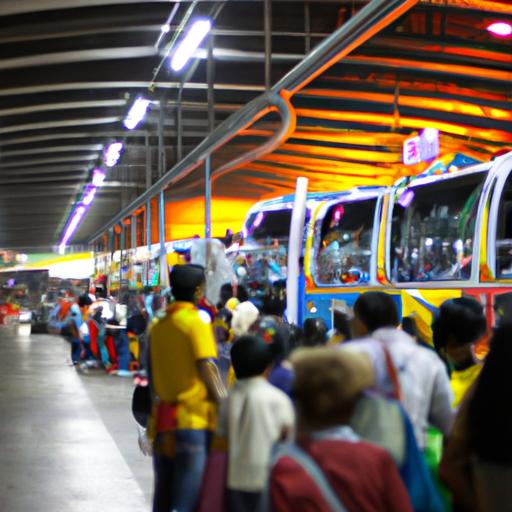Introduction
Bangkok, the vibrant capital of Thailand, is renowned for its bustling streets, rich culture, and mesmerizing attractions. Exploring this enchanting city can be an exhilarating experience, but with its sprawling size and heavy traffic, choosing the right mode of transportation is crucial. While there are various options available, traveling by bus in Bangkok offers a unique and affordable way to immerse yourself in the local lifestyle. In this guide, I will walk you through the ins and outs of navigating Bangkok’s bus system, ensuring an unforgettable journey through the city’s vibrant streets.
Overview of Bangkok’s Transportation System
Bangkok boasts a well-developed transportation network, comprising buses, trains, taxis, and motorbike taxis. While each mode has its advantages, buses stand out as an excellent choice for budget-conscious travelers seeking convenience and flexibility. With an extensive bus network covering almost every corner of the city, you can easily reach popular tourist destinations, shopping districts, and local neighborhoods without breaking the bank.
Importance of Traveling by Bus in Bangkok
Traveling by bus in Bangkok goes beyond just saving money; it offers a unique opportunity to mingle with locals, experience the city’s authentic charm, and witness its vibrant energy up close. Unlike the skytrain or subway, buses take you through the heart of Bangkok, allowing you to soak in the sights, sounds, and aromas that define this captivating city. Whether you’re an intrepid explorer or a curious traveler, hopping on a bus in Bangkok will undoubtedly enrich your journey and create lasting memories.
Now that we have set the stage for our adventure, let’s dive into the nitty-gritty of understanding Bangkok’s bus system. Keep reading to discover the different types of buses available, the routes they cover, and the fare structure in Section 2.
Understanding Bangkok’s Bus System
Types of Buses Available in Bangkok
When it comes to exploring Bangkok by bus, you’ll encounter a variety of bus types catering to different needs. The most common ones include:
1. Ordinary Buses
These are the backbone of Bangkok’s bus network, denoted by their vibrant colors and numbers. Ordinary buses are perfect for short-distance travel within the city, offering an affordable and convenient option for getting around.
2. Air-Conditioned Buses
If you prefer a more comfortable ride, opt for air-conditioned buses. These buses are typically equipped with better seating, making your journey more pleasant, especially during hot and humid days.
3. Express Buses
For longer journeys or traveling to destinations outside the city center, express buses are an ideal choice. These buses cover greater distances and make fewer stops, ensuring a faster and more efficient commute.
Routes and Destinations Covered by the Bus Network
Bangkok’s bus network spans across the entire city, connecting various neighborhoods, landmarks, and attractions. Whether you’re heading to the vibrant Chatuchak Weekend Market, the historic Grand Palace, or the bustling Khao San Road, there’s likely a bus route that will take you there. The routes are well-planned, with bus stops conveniently located near popular destinations, ensuring easy access for both locals and tourists.
To plan your journey effectively, consider using online resources, such as the official Bangkok Mass Transit Authority (BMTA) website or mobile apps like Moovit and Google Maps, which provide real-time information on bus routes, schedules, and even estimated arrival times.
Fare Structure and Payment Methods
Bangkok’s bus fare structure is incredibly affordable, making it an attractive option for budget travelers. The fare varies depending on the distance traveled, with prices typically ranging from 8 to 24 Thai Baht (approximately $0.25 to $0.75 USD). To pay for your bus ride, you can either use cash or opt for the convenient and cashless Rabbit Card, which can be topped up and used across various modes of transportation in Bangkok.
It’s worth noting that fares on some air-conditioned or special buses may be slightly higher due to their added amenities or longer routes. However, rest assured that even with these slight variations, traveling by bus in Bangkok remains a cost-effective choice compared to other modes of transport.
Now that you have a good understanding of the different bus types, routes, and fare structure, let’s move on to Section 3, where we’ll delve into the essential aspects of planning your bus journey in Bangkok.
Planning Your Bus Journey in Bangkok
Researching Bus Routes and Schedules
When it comes to planning your bus journey in Bangkok, the first step is to research the bus routes and schedules. Fortunately, there are several resources available to help you navigate the extensive network. The Bangkok Mass Transit Authority (BMTA) website provides a comprehensive list of bus routes, along with their schedules, fares, and estimated travel times. Additionally, smartphone apps like “Moovit” and “Google Maps” can assist you in finding the most convenient bus routes based on your location and destination.
Identifying Bus Stops and Terminals
Once you’ve determined the bus route you need to take, the next task is to identify the bus stops and terminals. Bus stops in Bangkok are usually marked with signs displaying the bus numbers and route information. Keep an eye out for designated bus shelters or marked areas along the roadside. At major bus terminals, such as the Bangkok Bus Terminal (Chatuchak) and the Southern Bus Terminal (Sai Tai Mai), you’ll find numerous buses departing to different regions of Thailand. Be sure to check the specific terminal for your desired destination.
Understanding Bus Signage and Route Numbers
Understanding the bus signage and route numbers is crucial to ensure you board the correct bus. Buses in Bangkok display their route numbers prominently on the front, rear, and sides. The route numbers are usually a combination of letters and numbers, indicating the specific route the bus follows. It’s important to note that some buses have different variations of the same route number, denoting different destinations or express services. Take a moment to familiarize yourself with the route numbers and their corresponding destinations before boarding.
With a solid plan in place, you’re now ready to embark on your bus journey in Bangkok. In the next section, we’ll provide you with essential tips to ensure a smooth and enjoyable travel experience. Stay tuned for “Tips for a Smooth Bus Travel Experience.”
Tips for a Smooth Bus Travel Experience
Choosing the Right Bus for Your Destination
When it comes to traveling by bus in Bangkok, choosing the right bus for your destination is essential. With numerous bus routes crisscrossing the city, it’s important to familiarize yourself with the route numbers and the areas they serve. You can easily obtain bus route information from the official Bangkok Mass Transit Authority (BMTA) website or use smartphone apps like Moovit or Google Maps for real-time bus schedules and routes. Additionally, keep an eye out for bus stop signs displaying route numbers and destinations to ensure you board the correct bus.
Navigating Through Bangkok’s Traffic
Bangkok’s notorious traffic can be daunting, but with a few tips, you can navigate through it smoothly. To avoid rush hour congestion, plan your bus travel outside of peak hours, typically between 7:00 AM and 9:00 AM and 5:00 PM and 8:00 PM. Be prepared for occasional delays due to traffic jams, especially during the rainy season or major events. It’s also worth noting that some buses have designated bus lanes, allowing them to bypass traffic, so keep an eye out for these lanes and use them to your advantage.
Managing Your Belongings on the Bus
When traveling by bus, it’s important to take precautions to protect your belongings. Keep your valuables close to you and avoid displaying expensive items that may attract unwanted attention. If you have a backpack or a bag, consider wearing it in front of you to have better control over it. Be mindful of your surroundings, especially when the bus is crowded, and be cautious of pickpockets. It’s also advisable to keep small change or a transit card handy to avoid fumbling with large bills or struggling to find exact change when paying your fare.
With these tips in mind, you’ll be well-prepared to embark on a smooth and enjoyable bus journey through the streets of Bangkok. In the next section, we will discuss important safety considerations to ensure a secure travel experience. Stay tuned for Section 5.
Safety and Security Considerations
Precautions to Take While Waiting at Bus Stops
When traveling by bus in Bangkok, it’s important to prioritize your safety and take certain precautions, especially while waiting at bus stops. Here are some tips to keep in mind:
-
Stay vigilant: Pay attention to your surroundings and be aware of any suspicious activities. Keep an eye on your belongings and avoid displaying valuable items.
-
Choose well-lit bus stops: Opt for bus stops that are well-lit and populated. Avoid waiting at secluded or dimly lit areas, especially during late hours.
-
Travel in groups: Whenever possible, travel with a companion or in a group. There is safety in numbers, and it can deter potential thieves or scammers.
Ensuring Personal Safety While Onboard
Once you board the bus, it’s essential to prioritize your personal safety. Here’s how you can stay safe while traveling:
-
Secure your belongings: Keep your belongings secure by holding onto them or placing them in the overhead compartments. Avoid leaving bags unattended or placing them on the seat next to you.
-
Be cautious of your surroundings: Stay alert and be mindful of the people around you. If someone makes you feel uncomfortable or suspicious, consider changing seats or alerting the bus conductor.
-
Avoid engaging in confrontations: In crowded buses, tensions can rise quickly. It’s best to avoid engaging in confrontations or arguments with other passengers, as it may escalate the situation and compromise your safety.
Dealing with Potential Scams or Pickpocketing Incidents
While rare, scams and pickpocketing incidents can occur in any bustling city, including Bangkok. Here’s how you can protect yourself:
-
Keep valuables secure: Carry your cash, passport, and other valuables in a secure money belt or a hidden pocket. Avoid displaying large sums of money or expensive jewelry.
-
Beware of distractions: Be cautious of individuals trying to divert your attention, such as someone spilling a drink on you or offering unsolicited help. These distractions may be attempts to steal your belongings.
-
Report any incidents: If you encounter any scams or become a victim of pickpocketing, report the incident to the bus conductor or the nearest authority figure. They can assist you in taking appropriate action and ensure your safety.
By following these safety precautions, you can navigate Bangkok’s bus system with confidence and peace of mind. Now that we’ve covered the importance of safety, let’s move on to the final section for additional resources and recommendations in Section 6.
Additional Resources and Recommendations
As you embark on your bus travel adventure in Bangkok, there are a few additional resources and recommendations that can enhance your experience. Let’s explore some useful tools and alternative transportation options to make your journey even more seamless.
Apps and Websites for Real-time Bus Information
To stay updated on bus routes, schedules, and real-time information, several apps and websites can be your trusty companions. One such app is “Moovit,” which provides accurate bus arrival times, route maps, and step-by-step directions. Another popular choice is the “BMTA Mobile Application,” offered by the Bangkok Mass Transit Authority, allowing you to track buses and plan your trips effortlessly. Additionally, websites like “Transit Bangkok” offer comprehensive guides and information on bus routes and fares.
Alternative Transportation Options in Bangkok
While buses are an excellent choice for getting around Bangkok, it’s worth exploring alternative transportation options for certain situations. The city’s efficient skytrain (BTS) and subway (MRT) systems connect major attractions and business districts, providing a quick and convenient way to navigate Bangkok’s traffic. Taxis and motorbike taxis are also widely available, offering door-to-door service for a slightly higher cost. Tuk-tuks, the iconic three-wheeled vehicles, are a popular choice for short distances or a unique cultural experience.
Must-Visit Attractions Easily Accessible by Bus
Bangkok is a city brimming with captivating attractions, and many of them can be conveniently reached by bus. Some notable landmarks worth exploring include the majestic Grand Palace, the sacred Wat Arun (Temple of Dawn), and the bustling Chatuchak Weekend Market. The vibrant Chinatown, serene Lumpini Park, and the iconic Wat Phra Kaew (Temple of the Emerald Buddha) are also must-visit destinations accessible by bus. With a little research and the help of bus routes, you can easily plan your itinerary to make the most of your time in Bangkok.
In conclusion, traveling by bus in Bangkok is an affordable, convenient, and immersive way to explore this remarkable city. From mingling with locals to discovering hidden gems, riding the bus allows you to experience Bangkok’s vibrant energy and cultural richness. By utilizing helpful apps, considering alternative transportation options, and visiting popular attractions accessible by bus, you can make the most of your journey through Bangkok’s bustling streets. So hop on board, embrace the adventure, and let the bus take you on a memorable ride through the heart of Bangkok.



